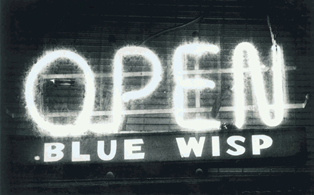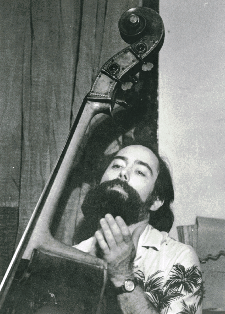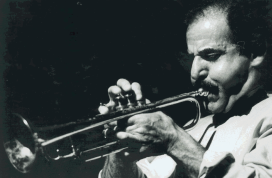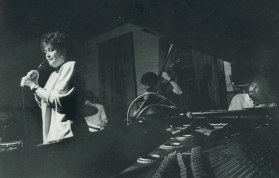Amy Culbertson, formerly entertainment editor at the Cincinnati Post, is a travel and food writer living in Fort Worth, Texas.
Note: The Blue Wisp remains open under a lease with Towne Properties at 700 Race St. in downtown Cincinnati. Rumors that it would close in Jan. 2013 proved to be unfounded, but there has been no official word of its fortunes since that time. Attempts to reach the owners of the Club have been unsuccessful.
The photos in the story below were taken on the last night at the Club's original location in Obryonville, all by the staff of the Cincinnati Post.
I spent many a night -- not
to mention the wee hours of many a morning -- at the various iterations of
Cincinnati's Blue Wisp jazz club, especially at its first two homes, in
O'Bryonville and on Garfield Place downtown. I was there as an avid jazz fan
and as the Cincinnati Post's entertainment editor; the Wisp was where I
met my husband, the late jazz drummer Ron McCurdy. I continued to return to the
club after I left for Detroit to become entertainment editor for the Detroit
Free Press; then after I moved to Texas and the Wisp took up residence on
east Eighth Street; and even after owner Marjean Wisby died, in 2006, though
its glory days were waning by then.

To the best of my knowledge, jazz started at the Blue Wisp in 1978. Paul and Marjean Wisby had purchased a little dump of a club in O'Bryonville -- you didn't want to go there in the daytime, when you could actually see what the interior looked like -- next door to Harry Garrison's player piano shop on Madison Road. The Wisbys were hardly jazz fans, but by some fluke they began hiring jazz groups, and by some fluke the club caught on as the hip place to go. I'm sure no one was more surprised than Paul and Marjean. The late saxist Jimmy McGary was generally thought of as the daddy of the region's jazz scene, and I expect his presence in one of the Wisp's early house groups, with Pat Kelly on piano, had something to do with the club's unlikely popularity. I remember there being lines to get in.
Then, in 1980, crack lead
trumpeter Don Johnson and Indiana drummer John Von Ohlen, who had played with
the Woody Herman and Stan Kenton big bands, formed the Blue Wisp Big Band to
play at the club on Wednesday nights, and that cemented the club's status as
the city's premier jazz club. It was a democratic big band composed of leading
local players, with the young Steve Schmidt on piano and Michael Sharfe on bass
(the original rhythm section, along with many of the founding musicians, is
still in place today).

Schmidt, Sharfe and Von Ohlen became the house trio, and soon the club was booking an impressive roster of national acts -- I believe Schmidt was mostly responsible for those early bookings, until pianist Phil DeGreg later took over -- along with local stalwarts like McGary and the late guitarists Cal Collins and Kenny Poole. The club also nurtured younger players like trumpeters Tim Hagans and Scott Wendholt, who would eventually move on to larger jazz spheres. It was a badge of honor among local musicians to be asked to play at the Wisp.
Especially on big-band Wednesdays and on weekends, musicians would flock to the club to hang out and listen after their sidemen gigs at hotels and country clubs. It was the quintessential smoky jazz dive, and after the official 2:30 a.m. closing time, when the "civilians," as Von Ohlen termed them, had left, Paul and Marjean would regularly keep the booze flowing after hours for the musicians and their friends. It was an open secret -- I don't know how the Wisbys got away with it -- but musicians could sometimes be seen stumbling out of the club at 5 or 6 a.m. after a night of drinking and swapping stories. (Marjean took a perverse delight in watching musicians get staggering drunk and disgrace themselves; hardly anything amused her more.) Jazz fans Fred and Helen Morr took on the role of patron for the big band, financing several albums and a trip to L.A. to record live at Carmelo's jazz club, as well as frequently hosting the club's out-of-town featured artists for the weekend. Nobody loved to hang with the musicians more than the Morrs did; they had regular seats at a front table.
There are a lot of myths
about the original Wisp, but a lot of the stories are true, and there were a
lot of memories embedded in those smoky, dingy walls. There was a lot of music
embedded in those walls, too (almost literally: I recall using the ladies'
room, separated by only a thin wall from the stage where 16 musicians wedged
themselves in to play on big-band nights, and feeling the walls of the tiny box
of a room sympathetically vibrate to a certain note from the bass).

When the Wisp got ready to
move to a new home on Garfield Place, dozens of musicians showed up to play on
its last night in O'Bryonville; the Post ran a photo spread on the
evening. The club continued strong at its new basement location; I remember how
exciting it was to descend the stairs and hear the music rush up to meet you.
One of my favorite memories there was hearing the trio of bassist Ray Brown,
guitarist Herb Ellis and pianist Monty Alexander. You could hardly wedge
yourself into the place; even the stairs were lined with spectators. It was
similarly crowded when Sun Ra brought his Arkestra's outlandish antics to the
club.

Paul Wisby had died in 1984, and Marjean was running the club as she and Paul always had. I think Marjean truly loved being behind the bar at the Wisp; her typically caustic pronouncements -- she had what my mother would have termed a “nasty mouth” -- always came with a wry and weary smile behind them. She never pretended to be a jazz aficionado or tried to direct the music, though she knew all the musicians' foibles and was not loath to make mock of them. With the Wisp, Marjean had found her niche in life, and she was, in her own odd and certainly unpretentious way, as much the animating spirit of the Blue Wisp as Elaine Kaufman was of the famed New York writers' and actors' hangout Elaine's.
The club's next move was to east Eighth Street, and Marjean died in 2006, leaving the club in limbo until it was bought by a partnership fronted by lawyer and sometime bassist Ed Felson. The club struggled along there, with the big band still as an anchor, but the frequency and stature of the national bookings declined.
A little more than a year ago, when Felson announced he was planning to move the club to the former Redfish restaurant and club space at Seventh and Race downtown -- and to add food service -- the handwriting was on the wall for anyone who cared to look. In December, Felson informed his e-mail subscribers that the club was in serious financial trouble and might be closing at the end of January. Since then, the club has limped on with no further public word from Felson or his partners, but its eventual fate remains murky.
For me, the news of the Wisp's imminent closing was sad, of course, but hardly unexpected. Anyone could have predicted the club's demise as soon as the most recent move and the plans to add food were announced. The interior space was totally inappropriate for an intimate jazz club, parking was problematic, the sound was bad and the owners inexperienced in the highly competitive business of running a restaurant. A lackluster booking policy left too few reasons to patronize the club outside of the big band's weekly gig. The first time I visited the new location, hungry to hear jazz after months of deprivation in Texas, I left so depressed I knew it was the last time I'd be there.
I have uncountable memories from the Wisp's first two locations, and a few from the third spot, but the truth is that the Wisp has been a sad shadow of its former self for some time now. The Blue Wisp was a vital part of my life for many years and one of the main reasons Cincinnati's jazz scene remained as rich as it did for as long as it did. But I find it painful to see the sad shell of the Wisp on figurative artificial life support, kept nominally breathing past its natural lifespan. It seems to me that many of the people who howl the loudest at the idea that Cincinnati might lose its “iconic” jazz club rarely ever show up there to hear actual jazz. I think it's time to let our beloved Blue Wisp die a peaceful death.
So let's raise a glass to
what the Blue Wisp once meant to the city, to jazz musicians and to jazz lovers
-- and then let's move on by vowing to support the musicians who still struggle
to keep jazz alive, against discouraging odds and for little reward, wherever
they may be playing around town. The Blue Wisp Big Band is the musicians who
play in it, not the club they play in, and surely they will be able to find
another home. Go hear them when they do.